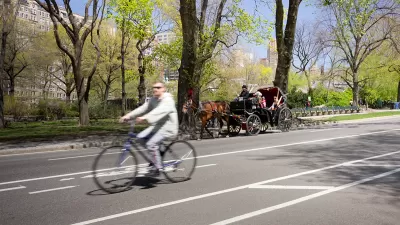A new report released by the New York City Department of Transportation (DOT) shows a steady increase in the number of bikers in the city. A lack of data, however, continues to be a problem for accurate assessment of the trend.

"Biking in New York City has been rising at a steady clip, according to a new report from NYC DOT, increasing about 50 percent between 2010 and 2014," reports Ben Fried.
Tempering Fried's excitement about the growing number of bikers in the city are the glaring omissions in the report: "What’s not so clear is how things changed in 2015, because the report lacks key information about bike traffic on the Hudson River Greenway."
The "Cycling in the City" report [pdf] combines data from the U.S. Census, a city Department of Health survey, and the DOT bike counts. "In some ways the report is a step up from the annual cycling metrics DOT has released in the past, which only included the DOT bike counts," writes Fried. "Folding in the Census bike commute numbers and health department survey data yields a more complete view of citywide and borough-by-borough cycling trends."
The problem begins in 2015, explains Fried. Because the report lacks "counts of cyclists on the Hudson River Greenway and 50th Street, or at the Whitehall ferry terminal" in 2015, it's impossible to compare that year to the years previous. Friend offers this recommendation: "Instead of waiting for DOT to release a report with all of these stats each year, the city should be publishing them as feeds on its open data portal, giving New Yorkers access to all the underlying numbers."
The article also includes a series of information-packed graphics to illustrate the trends in biking around the city.
FULL STORY: All of DOT’s Bike Metrics Should Be Published on NYC’s Open Data Portal

Pennsylvania Mall Conversion Bill Passes House
If passed, the bill would promote the adaptive reuse of defunct commercial buildings.

Planning for Accessibility: Proximity is More Important than Mobility
Accessibility-based planning minimizes the distance that people must travel to reach desired services and activities. Measured this way, increased density can provide more total benefits than increased speeds.

World's Largest Wildlife Overpass In the Works in Los Angeles County
Caltrans will soon close half of the 101 Freeway in order to continue construction of the Wallis Annenberg Wildlife Crossing near Agoura Hills in Los Angeles County.

Eviction Looms for Low-Income Tenants as Rent Debt Rises
Nonprofit housing operators across the country face almost $10 billion in rent debt.

Brightline West Breaks Ground
The high-speed rail line will link Las Vegas and the Los Angeles area.

Colorado Bans No-Fault Evictions
In most cases, landlords must provide a just cause for evicting tenants.
City of Costa Mesa
Licking County
Barrett Planning Group LLC
HUD's Office of Policy Development and Research
Mpact Transit + Community
HUD's Office of Policy Development and Research
Tufts University, Department of Urban and Environmental Policy & Planning
City of Universal City TX
ULI Northwest Arkansas
Urban Design for Planners 1: Software Tools
This six-course series explores essential urban design concepts using open source software and equips planners with the tools they need to participate fully in the urban design process.
Planning for Universal Design
Learn the tools for implementing Universal Design in planning regulations.


























